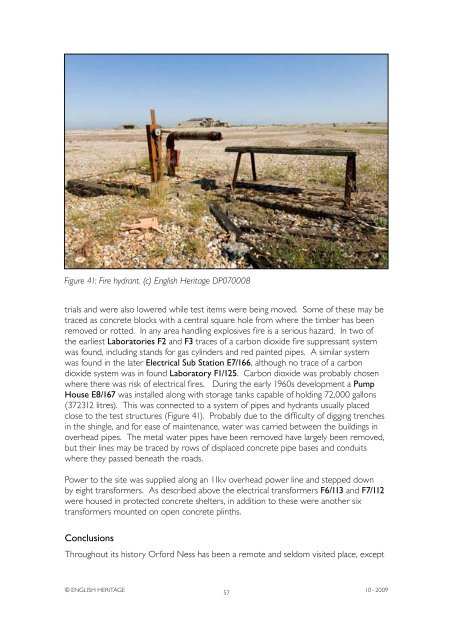Atomic Weapons Research Establishment. Orford ... - English Heritage
Atomic Weapons Research Establishment. Orford ... - English Heritage
Atomic Weapons Research Establishment. Orford ... - English Heritage
You also want an ePaper? Increase the reach of your titles
YUMPU automatically turns print PDFs into web optimized ePapers that Google loves.
Figure 41: Fire hydrant. (c) <strong>English</strong> <strong>Heritage</strong> DP070008<br />
trials and were also lowered while test items were being moved. Some of these may be<br />
traced as concrete blocks with a central square hole from where the timber has been<br />
removed or rotted. In any area handling explosives fire is a serious hazard. In two of<br />
the earliest Laboratories F2 and F3 traces of a carbon dioxide fire suppressant system<br />
was found, including stands for gas cylinders and red painted pipes. A similar system<br />
was found in the later Electrical Sub Station E7/166, although no trace of a carbon<br />
dioxide system was in found Laboratory F1/125. Carbon dioxide was probably chosen<br />
where there was risk of electrical fires. During the early 1960s development a Pump<br />
House E8/167 was installed along with storage tanks capable of holding 72,000 gallons<br />
(372312 litres). This was connected to a system of pipes and hydrants usually placed<br />
close to the test structures (Figure 41). Probably due to the difficulty of digging trenches<br />
in the shingle, and for ease of maintenance, water was carried between the buildings in<br />
overhead pipes. The metal water pipes have been removed have largely been removed,<br />
but their lines may be traced by rows of displaced concrete pipe bases and conduits<br />
where they passed beneath the roads.<br />
Power to the site was supplied along an 11kv overhead power line and stepped down<br />
by eight transformers. As described above the electrical transformers F6/113 and F7/112<br />
were housed in protected concrete shelters, in addition to these were another six<br />
transformers mounted on open concrete plinths.<br />
Conclusions<br />
Throughout its history <strong>Orford</strong> Ness has been a remote and seldom visited place, except<br />
© ENGLISH HERITAGE<br />
57<br />
10 - 2009

















